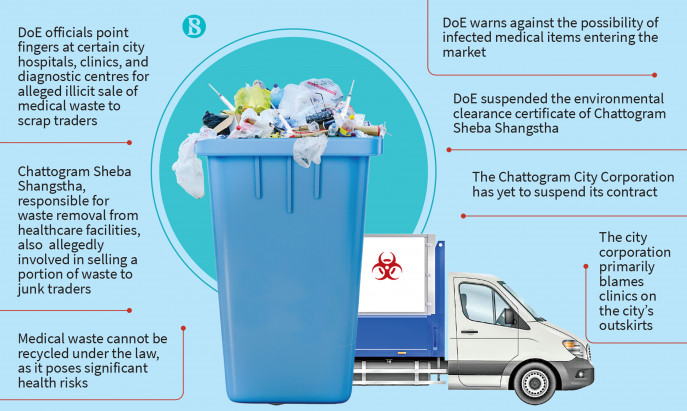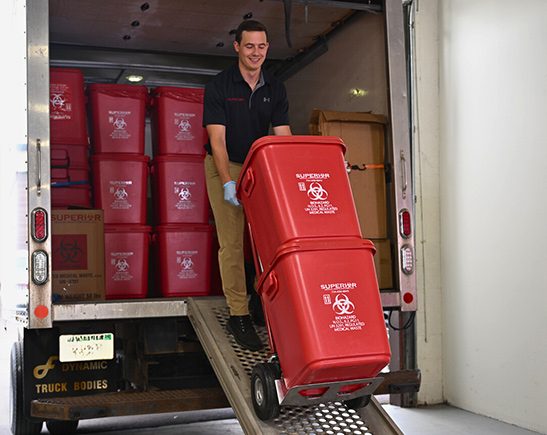Safeguarding Health: Professional Medical Waste Removal Services for a Tidy Setting
Safeguarding Health: Professional Medical Waste Removal Services for a Tidy Setting
Blog Article
Stay Ahead of Laws: Professional Suggestions on Medical Garbage Disposal
In a globe where the healthcare industry is frequently progressing, it is important for clinical facilities to remain ahead of regulations when it comes to the correct disposal of clinical waste. From understanding the various classifications of medical waste to applying the best collection and segregation techniques, this discussion will certainly offer actionable pointers and important understandings to assist centers stay in advance of laws in the ever-changing landscape of medical waste disposal.
Understanding Clinical Waste Categories
Understanding medical waste categories is crucial for correct disposal and administration in medical care facilities. Clinical waste refers to any type of waste generated by health care tasks that may present a threat to public health and wellness or the environment. It is vital to categorize medical waste properly to ensure its risk-free handling, therapy, disposal, and transport.
There are several classifications of clinical waste that medical care facilities need to be aware of. One of the most common classifications consist of transmittable waste, pathological waste, sharps waste, pharmaceutical waste, and chemical waste. Each category has particular standards and laws for its proper administration and disposal.
Transmittable waste consists of materials contaminated with blood or other bodily liquids, such as handwear covers, dress, and laboratory cultures. Pathological waste describes human tissues, body organs, or body components that call for special delivery and disposal. Sharps waste consists of made use of needles, syringes, and other sharp objects that can cause injury and transfer infections. Pharmaceutical waste makes up ended, extra, or polluted medicines that require mindful handling and disposal. Chemical waste consists of solvents, anti-bacterials, and various other chemical compounds made use of in healthcare facilities.
Staying Up-To-Date With Regulatory Changes
Remaining existing with governing modifications is vital for medical care centers to make sure compliance and proper monitoring of clinical garbage disposal. medical waste removal. With laws frequently progressing, it is vital for health care facilities to remain updated to prevent charges, fines, and possible damage to the environment and public wellness
To remain ahead of governing modifications, healthcare centers ought to establish a system for tracking and tracking updates. This can be done by registering for regulative newsletters, participating in workshops and conferences, and proactively participating in sector associations. In addition, centers should mark a personnel or team in charge of staying educated and disseminating details to appropriate stakeholders.
Normal communication with governing agencies is additionally essential. Medical care facilities need to establish partnerships with local, state, and government firms to ensure they are mindful of any adjustments in regulations that might impact their waste monitoring practices. This can be done through routine meetings, participation in public comment periods, and positive involvement with regulative firms.
In addition, health care centers must consider partnering with waste monitoring business that concentrate on medical garbage disposal (medical waste disposal services with WasteX). These business are usually well-versed in the most current laws and can provide assistance and support to make sure conformity
Implementing Proper Collection and Segregation Techniques
To properly take care of clinical garbage disposal, healthcare facilities should develop appropriate collection and partition methods according to regulatory guidelines. Implementing these techniques guarantees the risk-free handling and disposal of potentially dangerous materials, secures the setting, and lessens the danger of injuries and infections to medical care employees and the basic public.
Appropriate collection and segregation methods involve using designated containers and labeling systems. Medical care facilities need to give plainly identified containers for different types of clinical waste, such as sharps, contagious waste, pharmaceutical waste, and non-hazardous waste. These containers must be color-coded and clearly significant to stay clear of confusion and promote very easy recognition.
Furthermore, healthcare centers must train their team on the proper helpful site procedures for collecting and setting apart medical waste. This includes enlightening them on the different kinds of waste, the appropriate containers to make use of, and the importance of following guidelines and standards. Normal training sessions and refresher course training courses ought to be performed to guarantee that personnel remain up-to-date on ideal methods.
Furthermore, health care facilities need to establish a system for normal collection and disposal of clinical waste. This may involve partnering with qualified waste administration companies that focus on medical waste disposal. These firms will make sure that the collected waste is moved and taken care of in compliance with governing requirements.
Selecting the Right Disposal Approaches

Incineration is just one of one of the most common and efficient approaches for dealing with particular sorts of medical learn the facts here now waste, such as pathological waste and sharps. It involves the regulated combustion of waste at heats, decreasing it to ash. However, incineration can launch damaging pollutants right into the air and add to air contamination.

Chemical therapy involves the use of chemicals to sanitize and counteract the waste. Microwave treatment uses microwave energy to warmth and decontaminate the waste.
Ensuring Compliance With Paperwork and Training
After meticulously considering the suitable disposal techniques for medical waste, health care facilities need to ensure conformity with laws and lessen ecological influence by applying reliable paperwork and training procedures. This step is important in preserving a risk-free and sustainable setting for both health care workers and the general public.

Training is equally crucial in ensuring conformity with regulations. Healthcare workers that handle medical waste must obtain appropriate training on waste segregation, taking care of, and disposal treatments. This training should cover topics such as the appropriate usage of individual protective equipment, identification of various kinds of waste, and the proper disposal methods for each waste classification. By supplying thorough training, healthcare facilities can equip their personnel to make enlightened decisions and lessen the danger of incorrect garbage disposal.
Final Thought
Finally, staying ahead of regulations in clinical garbage disposal is crucial for healthcare facilities. medical waste removal services. Comprehending the different categories of clinical waste, remaining updated with regulatory changes, applying appropriate collection and segregation methods, picking the proper disposal techniques, and guaranteeing compliance via paperwork and training are all important steps. By adhering to these guidelines, healthcare companies can successfully dispose and manage of clinical waste in a accountable and safe fashion
From comprehending the different classifications of medical waste to executing the appropriate collection and segregation methods, this conversation will give actionable tips and useful insights to assist centers stay in advance of policies in the ever-changing landscape of clinical waste disposal. - medical waste disposal services with WasteX
The most common classifications consist of transmittable waste, pathological waste, sharps waste, pharmaceutical waste, and chemical waste. Medical care facilities ought to offer clearly identified containers for various kinds of clinical waste, such as sharps, transmittable waste, pharmaceutical waste, and non-hazardous waste. Medical care centers should establish a comprehensive system to tape-record and track all elements of medical waste disposal, including types of waste generated, quantities, and disposal methods used. Healthcare workers who handle medical waste should receive appropriate training on waste segregation, handling, and disposal treatments.
Report this page